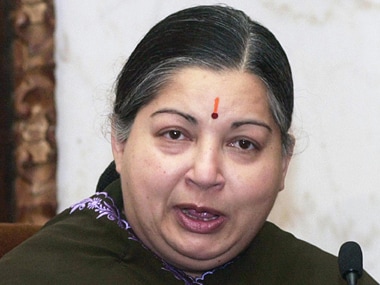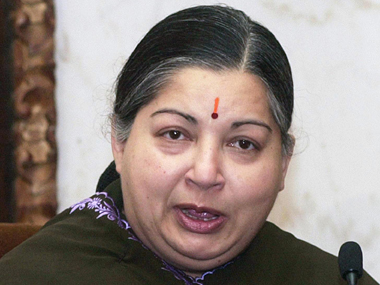That the late Tamil Nadu Chief Minister J Jayalalithaa (her name is sometimes spelled Jayalalitha) was larger than life and endeared herself to millions of Tamils in Tamil Nadu is a given. But, the charismatic leader shared a love-hate relationship with her birth place, Karnataka. It was almost as though she wanted to prove to Tamil Nadu that she was more Tamil than the Tamilians. Born in Mandya, Karnataka, the epicentre of the Cauvery dispute between the two states, one would have expected Jayalalithaa to take a softer stand on the water sharing formula, especially as those affected mostly were farmers from her hometown of Mandya. But, she was the Iron Lady when it came to negotiations with Karnataka on water sharing. Although, the Cauvery basin spreads across the four states of Karrnataka, Tamil Nadu, Kerala and Puducherry, the decades old dispute has largely been between Karnataka and Tamil Nadu, with violent protests erupting in the two states, every other drought year. The issue might date back to 1892 when an agreement was filed between Madras Presidency and Mysore for arbitration. Several attempts were made to arbitrate between the two states by the Supreme Court and the Centre too. But, with high doses of jingoistic adrenaline pumping the politics of the two states, the Cauvery dispute between the two states was a call for the leaders of the two states down the years to either fuel these emotions or sit across the table in relative calm level headedness and reach a compromise solution. [caption id=“attachment_3142058” align=“alignleft” width=“380”]  Late Tamil Nadu CM J Jayalalithaa. AFP[/caption] In the recent violent protests and various bandhs called in Karnataka and Tamilnadu just months ago, protestors in both the states, targeted both the chief ministers of the two affected states, Siddaramaiah of Karnataka and J Jayalalithaa of Tamilnadu by burning their effigies and vandalizing their hoardings. While in the past, theatres, schools and Tamil speaking areas were targeted in Bengaluru by pro-Karnataka protestors, this year, even restaurants and bus carriers with roots in Tamilnadu were targets of violent vandalism. Could the Cauvery dispute have found an easier solution, if Jayalalithaa had been partial to her birthplace and listened to the plight of the Mandya farmers as much as she did to those of the farmers from Tamilnadu? Jayalalithaa had enough and more Karnataka links for anyone to think so. She was an Iyengar Tamil Brahmin born on 24 February 1948, at Melukote, in Pandavapura taluka, Mandya district. Her very name Jayalalithaa, came from the two homes where she lived as a child in Mysore. One was “Jaya Vilas” and the other “Lalitha Vilas”. Both sides of her parentage had links with two ubiquitous Karnataka legacies – the royal Wodeyars and Hindustan Aeronautics limited or HAL. Her paternal grandfather, Narasimhan Rengachary, was a court physician to Maharaja Krishna Raja Wadiyar IV and her maternal grandfather, Rangasamy Iyengar, worked with HAL in Mysore. After her father Jayaraman died, when she was two years old, her widowed mother Vedavalli returned to her father’s home in Bangalore in 1950. Jayalalithaa was even a Cottonian, studying for a while at the Bishop Cottons Girls school on St. Marks School. The school has even put up a photo of Jayalalithaa in their school lobby. When her mother relocated to Madras to act in films, Jayalalithaa lived with her mother’s sister Padmavalli and with maternal grandparents from 1950 to 1958 in Mysore. With her fluency and skill with languages, she spoke fluent Kannada and even spoke Kannada with former Karnataka chief Ministers Jagadish Shettar 2012 and SM Krishna 2002, when they were in Delhi to discuss the Cauvery dispute. She also is known to have conversed in Kannada with co-stars from the state. So, what soured her memories of Karnataka and similarly turned Karnataka against their own daughter? The Times of India report says that it was a statement seen as anti-Kannada that shortened Jayalalithaa’s career in Sandalwood. In 1972, when she was shooting at Premier Studio in Mysuru for the Tamil film, Ganga Gowri, she made a rare political misstep, saying. “I know Kannada as I was born in Melkote in Karnataka, but I am Tamil.” Her dance show scheduled as part of the Dasara celebration in Mysore was cancelled and a film she was to act with Kannada superstar Rajkumar was also called off. However, what is interesting to note is that Jayalalithaa continued her spiritual links with Karnataka by even going to the Chamundeswari temple in Mysore for her 63rd birthday in 2011. For a Dravidian leader, being Brahmin, religious and also Convent educated were already too many negative combinations as it were, so perhaps keeping the strong Thevar community on her side, through her best friend Sasikala Natarajan and the present chief minister O Pannerselvam was a political imperative and eschewing her Karnataka Iyengar Brahmin roots might have been a political necessity too. Perhaps, what also soured Jayalalithaa’s memories of Karnataka and made her bitter towards the state was her experience in a Karnataka jail. When the 18-year-old disproportionate assets case against Jayalalithaa and her aides was transferred to Bangalore, the Special Court in Bangalore in September, 2014, convicted Jayalalithaa to four years in jail and fined her ₹100 crore. This forced her to step down as chief minister. However, the very next year, in May 2015, the Karnataka High Court overturned the trial court’s verdict and acquitted Jayalalithaa and others of all charges, which paved the way for Jayalalithaa to return to power as chief minister of Tamil Nadu last year. The manifesto that brought her back to power had one salient feature — that the new government would solve the age — old Cauvery dispute with Karnataka. As chief minister, Jayalalithaa quickly put this into practice, by taking legal action against Karnataka for not adhering to the Cauvery Water Tribunal’s order of releasing water to Tamilnadu. The mistrust and suspicion that grew between the two states was that of politics, however, the people of the two states have always shared a good rapport with several Kannadigas and Tamils living and working in both states. Now, we will have to see, how the political theatre between the two states will pan out, with the new Tamil Nadu chief minister, O Paneerselvam at its helm. Will the blow-hot blow-cold relationship between the two states improve?
Could the Cauvery dispute have found an easier solution if Jayalalithaa had been partial to her birthplace and listened to the plight of the Mandya farmers as much as she did to those from Tamil Nadu?
Advertisement
End of Article


)
)
)
)
)
)
)
)
)



